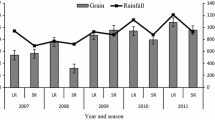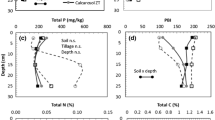Abstract
Using soils with an acidic subsurface layer, three glasshouse experiments were carried out to evaluate the effect of placement method and application rate of triple superphosphate (TSP) and North Carolina phosphate rock (NCPR) on dry matter (DM) yields. Time of application of NCPR on DM yield response of wheat was also studied.
For Experiment 1, soil was collected in depth intervals of 0–2; 4–6; 6–8; and 8–10 cm from a red earth (chromic luvisol). The treatments included two P sources (TSP and NCPR), three placement methods (broadcast, banded or mixed into the subsurface layer, 6–8 cm), and six application rates. In this P deficient soil with an acidic subsurface layer, there was relatively little effect of application method of TSP on wheat yield responses. The maximum dry matter yield responses for broadcast, band and mix application methods was 30, 42 and 50 %, respectively. Responses to NCPR broadcast, band and mix methods were 20, 9 and 44 %, respectively. Mixing NCPR into to acidic subsurface layer produced yields similar to those from TSP although a higher application rate of P as NCPR was needed to achieve this outcome.
Treatments for Experiments 2 and 3 were time of application of NCPR (0 and 30 days before sowing) and rate of application of NCPR (0 and 40 mg P/pot). In Experiment 2 (same soil as Experiment 1) application of NCPR prior to sowing, resulted in higher Colwell P concentration than when applied at sowing, but time of application had no effect on final DM yields. Experiment 3 used a red podzolic (chromic luvisol) soil which had a lower P-status, was more acid and had a lower exchangeable Ca2+ concentration than the red earth. Application of NCPR prior to sowing resulted in lower DM yield than when it was applied prior to sowing.
Similar content being viewed by others
References
AOAC (1984) Official Methods of Analysis, 14th edn. Erlington, Va: Association Official Agricultural Chemists
Bolland MDA and Gilkes RJ (1990) Rock phosphates are not effective fertilizers in Western Australian soils: a review of one hundred years of research. Fert Res 22: 79–95
Colwell JD (1963) The estimation of the phosphorus fertilizer requirements of wheat in southern New South Wales by soil analysis. Aust J Exp Agric Anim Husb 3: 190–197
Conyers MK and Scott BJ (1989) The influence of surface incorporated lime on subsurface acidity. Aust J Exp Agric 29: 201–207
Fergus IF and Stirk GB (1962) The control of soil physical conditions in pot trials. Aust J Exp Agric Anim Husb 1: 119–125
Gillman GP and Sumpter EA (1986) Surface charge characteristics and lime requirements of soils derived from basaltic, granitic and metamorphic rocks in high-rainfall tropical Queensland. Aust J Soil Res 24: 173–192
Helyar KR and Porter WM (1989) Soil acidification, its management and processes involved. In: Robson AD (ed) Soil acidity and plant growth, pp 61–101. Academic Press Australia, Marrickville (NSW)
John MK (1970) Colorimetric determination of phosphorus in soil and plant materials with ascorbic acid. Soil Sci 100: 214–220
Kumar V, Gilkes RJ and Bolland MDA (1991) Residual phosphate fertilizer compounds in soils: 11. Their influence on soil tests for available phosphate. Fert Res 30: 31–38
Loutit A, Stallwood P and Cox WJ (1968) Drilled versus top-dressed superphosphate for cereal production. J Agric West Aust 9: 418–421
Mackay AD and Syers JK (1986) Effect of phosphate, calcium, and pH on the dissolution of a phosphate rock in soil. Fert Res 10: 175–184
Mackay AD, Syers JK and Greg PEH (1984a) Ability of chemical extraction procedures to assess the agronomic effectiveness of phosphate rock materials. NZ J Agric Res 27: 219–230
Mackay AD, Syers JK, Tillman RW and Greg PEH (1986) A simple model to describe the dissolution of phosphate rock in soils. Soil Sci Soc Am J 50: 291–296
McLean EO (1982) Soil pH and lime requirement. In: Page AL (ed) Methods of soil analysis: Chemical and microbiological properties, 2nd, pp 199–224. American Society of Agronomy, Madison
Nelson DW and Sommers LE (1982) Total carbon, organic carbon and organic matter. In: Page AL (ed) Methods of soil analysis: Chemical and microbiological properties, 2nd, pp 539–579. American Society of Agronomy, Madison
Northcote KH, Hubble GD, Isbell RF, Thompson CH and Bettenay E (1975) A description of Australian soils. Commonwealth Scientific and Industrial Research Organization. Wilke Company Limited, Clayton, Victoria
Olsen SR and Sommers LE (1982) Phosphorus. In: Page AL(ed) Methods of soil analysis: Chemical and microbiological properties, 2nd, pp 403–430 American Society of Agronomy, Madison
Piper CS (1942) Soil and Plant Analysis. A laboratory manual of methods for the examination of soils and the determination of the inorganic constituents of plants. The University of Adelaide, Adelaide
Purnomo E (1992) Management of phosphorus fertilizer in soil with an acid subsurface layer. MAppSc Thesis. CSU Wagga Wagga, Australia
Rudd CL and Barrow NJ (1973) The effectiveness of several methods of applying superphosphate on yield response by wheat. Aust J Exp Agric Anim Husb 13: 430–433
Sale PWG (1989) The agronomic efficiency, the economic and the quality of direct applied ground and partially acidulated phosphate rock. In: Seminar of the Role of Phosphates in Balanced Fertilization. Marrakech, Morocco, 24–27 October 1989
Simmons KV and Godyn DL (1983) Phosphorus needs for wheat in southern NSW. Agdex. 112/23
Stace HCT, Hubble GD, Brewer R Northcote KH, Sleeman JR, Mulcahy MJ and Hallsworth EG (1968) A Handbook of Australian Soils. Rellim Technical Publications, Glenside South Australia
Zadoks JC, Chang TT and Konzak CF (1974) A decimal code for the growth stages of cereals. Weed Res 14: 415–421
Author information
Authors and Affiliations
Rights and permissions
About this article
Cite this article
Purnomo, E., Black, A.S. Wheat growth from phosphorus fertilizers as affected by time and method of application in soil with an acidic subsurface layer. Fertilizer Research 39, 77–82 (1994). https://doi.org/10.1007/BF00750159
Received:
Accepted:
Issue Date:
DOI: https://doi.org/10.1007/BF00750159




